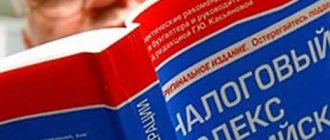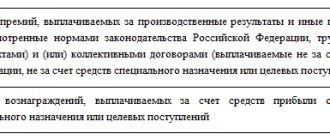In this article we will look at the codes for standard tax deductions, analyze the table of codes for standard tax deductions and show an example of calculating a tax deduction, as well as talk about legislation and answer the most common questions.
The obligation to pay taxes and fees to the Russian treasury is assigned to citizens by the Constitution of the Russian Federation. Each tax payer can apply to the place of employment or to the tax authority for a tax deduction upon presentation of documents proving the existence of such a right - a kind of benefit that makes it possible to legally not pay tax, or to demand the return of money already transferred to pay it.
Tax deduction is an amount that reduces the amount of income (tax base), from which personal income tax is withheld at a rate of 13%. Or is it money sent to the budget earlier to pay personal income tax, which can be returned to the company’s employee. A similar right arises for those who are recognized as residents of the Russian Federation from the point of view of the Tax Code of the Russian Federation and have income on which personal income tax is charged at a rate of 13%.
A standard tax deduction is an amount that reduces the tax base for personal income tax. At the moment, employees of enterprises whose annual salary does not exceed 350 thousand rubles can take advantage of the deduction. From the moment this amount is exceeded, the deduction ceases to be provided.
Child deduction codes in 2021
Codes for types of deductions were approved by Order of the Federal Tax Service dated September 10, 2015 No. ММВ-7-11/387.
It is worth saying that the child tax deduction code in 2021 depends not only on which child is counted, whether the child is disabled, but also on who the deduction is provided to (for example, a parent or guardian). For example: the deduction code for the first child, when the deduction is provided to the parent, is 126, and the deduction codes for two children in 2021 for guardians are 130 (first child) and 131 (second child).
Thus, pay attention to several conditions under which child tax credits for children are provided in 2021.
Table. Deduction codes for children in 2021 (single deduction):
| To whom is the single deduction granted? | Condition of provision | Who is entitled to the deduction / Deduction code | |
| Parent, spouse of a parent, adoptive parent who cares for the child | Guardian, trustee, adoptive parent, spouse of the adoptive parent who is providing for the child | ||
| First child | Age up to 18 years or full-time student, graduate student, resident, intern, student, cadet under the age of 24 | 126 | 130 |
| Second child | 127 | 131 | |
| Third and each subsequent child | 128 | 132 | |
| Disabled child | Age up to 18 years | 129 | 133 |
| Disabled child of group I or II | Full-time student, graduate student, resident, intern, student under the age of 24 | ||
Standard tax deduction codes: why are they needed?
Tax deduction codes are a code consisting of numbers. They are designed to format a table in the 2-NDFL certificate in order to speed up the processing of the document by tax officials.
Certificate 2-NDFL, in turn, is the main document confirming that an employee of an enterprise has received a certain amount of salary, from which personal income tax is transferred. It serves:
- a report to the Federal Tax Service of tax agents on the cash receipts of the main taxpayers and the personal income tax collected from these amounts;
- a tax agent’s report on the reasons why personal income tax could not be withheld from the earnings of the main taxpayer;
- paper proving the amount of income of the taxpayer at the place of work and the amount of personal income tax transferred from them, when the taxpayer applies to the company of a new potential employer, to the tax service department, to a credit institution, etc.
Child tax deduction: double deduction code
Below is a table with deduction codes for children, if deductions in 2021 are provided in double size. This is possible, for example, when the only parent or one of the adoptive parents wrote an application for refusal to receive a tax deduction for the child.
| Who is eligible for double deduction? | Condition of provision | Who is entitled to the deduction / Deduction code | |||
| Sole parent, adoptive parent | Sole guardian, trustee, foster parent | One of the parents of their choice based on an application for refusal of one of the parents to receive a tax deduction | One of the adoptive parents of their choice based on an application for refusal of one of the adoptive parents to receive a tax deduction | ||
| First child | Age up to 18 years or full-time student, graduate student, resident, intern, student, cadet under the age of 24 | 134 | 135 | 142 | 143 |
| Second child | 136 | 137 | 144 | 145 | |
| Third and each subsequent child | 138 | 139 | 146 | 147 | |
| Disabled child | Age up to 18 years | 140 | 141 | 148 | 149 |
| Disabled child of group I or II | Full-time student, graduate student, resident, intern, student under the age of 24 | ||||
Read also
16.03.2020
Conditions for receiving a double deduction
A parent (adoptive parent, guardian, trustee) has the right to receive a tax deduction for a child (children) in double the amount, but only if there is one of two grounds:
1) if there is a refusal of one of the parents to receive a deduction;
2) if the parent (foster parent, guardian, adoptive parent) is the only one and this is documented.
In the first case, the second parent is required to provide a statement of his refusal to receive a deduction for the child (children), as well as a copy of the 2-NDFL certificate from his place of work, which will confirm that the second parent did not receive the deduction.
In the second case, the status of the only parent must be confirmed by a copy of the relevant document (Letter of the Ministry of Finance of the Russian Federation No. 03-04-05/1-657 dated May 23, 2012). Such documents may include:
to confirm the status of a single mother: a child’s birth certificate, in which the “Father” column is not filled in, a birth certificate in form 2 from the registry office if the mother independently entered information about the child’s father, as well as a notice of the absence of a civil status record from organs (the mother must not be married);
- to recognize a parent as missing or dead: a court decision to recognize one of the parents as missing or dead;
- to confirm the death of the second parent: his death certificate;
- to confirm the sole adoptive parent (guardian, trustee): an act of the guardianship and trusteeship authority on the appointment of a sole guardian (trustee).
Moreover, if a single mother or single father gets married (regardless of whether the child is adopted by the spouse or not), then it is necessary to stop providing double deductions from the month following the month of marriage registration. However, the fact of marriage does not apply to sole guardians, adoptive parents and trustees - this rule does not apply to them.
It is also important to note that no other cases are grounds for receiving a double deduction. For example, conditions under which the second parent is deprived or limited in parental rights or if he does not pay child support and does not participate in providing for the child will not be suitable.
What social benefits are provided for single mothers - amounts according to the Tax Code of the Russian Federation
Single mothers, adoptive parents and guardians are given the right under the Tax Code of the Russian Federation to a double deduction per child (for each child). They are calculated as follows:
- 2800 rub. - for the first;
- 2800 rub. - for the second;
- 6000 rub. – for the third (fourth, fifth..);
- 24,000 – for a disabled child.
In a family where there are both parents, anyone can have such a deduction if one of them refuses the benefit in favor of the other.
Professional personal income tax deductions
This category of deductions can be used infrequently in practice. At the same time, there may be situations when a professional deduction may be needed. For example, in the field of R&D or art.
There are few such codes, and they are all named in one article 221 of the Tax Code of the Russian Federation:
| Code | Deduction |
| Professional deductions | |
| 403 | The amount of actually incurred and documented expenses directly related to the performance of work (provision of services) under civil and process agreements |
| 404 | The amount of actually incurred and documented expenses associated with the receipt of royalties or remunerations for the creation, execution or other use of works of science, literature and art, remuneration to the authors of discoveries, inventions, utility models and industrial designs |
| 405 | The amount within the limits of the standard costs associated with receiving royalties and remunerations for the creation, performance or other use of works of science, literature and art, rewards to the authors of discoveries, inventions, utility models and industrial designs (as a percentage of the amount of accrued income) |
Other deductions that may be useful when preparing 2-NDFL
In this section, we will look at deduction codes that are “tied” to certain income codes. Where there is income that is known to be exempt from personal income tax in a limited amount, there must be a code for the amount that is exempt from personal income tax (in fact, this is also a deduction).
For example, if the certificate contains an amount with income code 2720 (the cost of the gift), then in addition to it there must also be a deduction code 501 (non-taxable 4,000 rubles, within which it is allowed to give a gift from an organization or individual entrepreneur without withholding personal income tax).
Thus, the table of deductions should be compared with the table of other income codes.
| Deduction code | Name of deduction |
| Other deductions | |
| 501 | Deduction from the value of gifts received from organizations and individual entrepreneurs |
| 502 | Deduction from the cost of prizes in cash and in kind received at competitions and competitions held in accordance with decisions of the Government of the Russian Federation, legislative (representative) bodies of state power or representative bodies of local self-government |
| 503 | Deduction from the amount of financial assistance provided by employers to their employees, as well as to their former employees who resigned due to retirement due to disability or age |
| 504 | Deduction from the amount of compensation (payment) by employers to their employees, their spouses, parents and children, their former employees (age pensioners), as well as to disabled people, the cost of medications purchased by them (for them), prescribed to them by their attending physician |
| 505 | Deduction from the value of winnings and prizes received at competitions, games and other events for the purpose of advertising goods (works, services), etc. |
Amount of income tax if an individual's income is below the standard deduction
13% income tax is calculated on income reduced by the amount of standard deductions.
Accounting for tax and taxable base is carried out on an increasing annual basis.
If during some periods the employee does not receive wages, or its amount decreases below the standard NV, then the actual income tax withheld from the beginning of the year may exceed the calculated level. Find out about tax deductions when selling a car here.
For example. Standard deduction for three children is 5800 rubles. Salary in January – 20,000 rubles. The monthly income for paying tax is 14,200 rubles. January personal income tax amounted to 1846 rubles. (14200 x 13%).
In February, the employee received 5,000 rubles, which is less than the deduction due. When calculating personal income tax on an accrual basis, the actual overpayment for 2 months is obtained: (20,000 + 5,000 – 5,800 x 2) x 13% = 1,742 (rub.). Personal income tax for 2 months 1742 rub. < 1846 rub. paid in January.
In the video - deductions and children in the family:
The resulting difference (104 rubles) means an overpayment since the beginning of the year.
It is taken into account in subsequent months for subsequent accruals.
If the debt to the employee remains, he has the right to apply to the tax service for a refund of the overpaid amount. This material will tell you what you can get a tax deduction for.
This opportunity continues during the current calendar year.
Deduction amount by code 104
It should be taken into account that the deduction under code 104 belongs to the standard category. Its main difference from property deductions is that transfer to other reporting periods is impossible.
The deduction under code 104 is a fixed amount, its size is fixed at the legislative level and amounts to 500 rubles in each month of the reporting year.
Calculation example
Let’s assume that a person who has the right to receive a deduction under code 104 earned 30,000 rubles in a month. If there is no right to other deductions, the amount subject to tax is calculated as follows:
30,000 - 500 = 29,500 rubles
If a person worked for a whole reporting year, then the total amount of deductions for this period will be:
500 x 12 = 6000 rubles
The necessary calculations are made by the employer's accounting service, which also carries out the calculation and withholding of income tax, as well as the preparation of all necessary reporting.
What tax deduction is due to a single mother in 2020?
Every working citizen pays taxes on their income. But there are categories of citizens who have certain benefits. It should be noted that a single mother can receive a double tax deduction for personal income tax.
Single mother status
A woman caring for a child without the support of a father is not always a single mother in the legal sense.
To be assigned official status, you must contact government agencies with documents confirming the absence of the second parent.
The mother can apply for a certificate either immediately after the birth of the baby or after a while. In some cases, you will need to confirm your status through the courts.
Labor legislation provides a large number of benefits for those who raise a child without the help of a second parent.
This could include additional days of vacation, shortened working hours, or financial compensation. The latter include benefits when paying income tax.
Rights of a single mother: at work, to alimony, to vacation.
Features of deduction for preferential categories
The Tax Code (Article 218) provides for the return of part of the cash payments paid from official income for parents of minors. However, there are some peculiarities of income tax for single mothers.
Women assigned this status are entitled to a double deduction. This privilege is enshrined in law (Plenum Resolution No. 1012).
It is tied to the fact that if both parents are present, both the mother and father receive the deduction. In the event that one of the parents is absent, the refund that he could have received should be sent to the mother raising the baby.
What benefits are available to a single mother?
Many women who independently care for a child are concerned about whether single mothers are entitled to tax benefits.
If a woman’s status is officially assigned, as evidenced by a document issued by government agencies, then she can receive a double tax deduction.
This category of beneficiaries includes mothers who:
Deductions for personal income tax
Tax deductions for personal income tax for women who independently raise a minor are provided until the child reaches 18 years of age.
If he continues his full-time studies, that is, continues to be dependent on a woman, then the period is extended to 23 years.
Features of tax deduction for single mothers
Tax benefits are available for all working parents raising minors. Their size is established by the Tax Code.
Their size is:
- for the first child – 1400 rubles,
- for all other children - 3000 rubles.
The tax benefit for parents caring for a disabled person is 12,000 rubles.
If we talk about how taxes are deducted from the wages of single mothers, then in this case the amounts will be doubled.
If a woman is raising one child, she will be able to receive a tax benefit in the amount of 2,800 rubles, more than two - 6,000 rubles.
Documents for obtaining a tax deduction for a single mother
To receive benefits, a single mother must contact the accounting department of the company where she is officially employed.
The application is submitted from the date when the grounds for receiving a tax deduction arose. At the beginning of the year, documents are updated.
Women raising a child without a father are interested in what certificates will be required:
- statement;
- birth certificate or adoption document;
- certificate F-25;
- papers confirming the child’s education;
- certificate of disability (if available).
If a woman has just moved to a new place of work, she will need to take a 2-NDFL certificate from her previous place of employment.
Download the application for double tax deduction here:
Application for double tax deduction.Download
Application of tax deduction
The tax benefit is valid for single mothers until their annual income exceeds 350,000 rubles. Once this amount has been accrued, payments will stop.
Speaking about how the tax deduction is applied, it should be noted that the organization’s accountants are involved in the procedure.
A woman only needs to submit the relevant documents and an application indicating:
- your personal data;
- information about dependent children;
- list of attached certificates;
- date of compilation.
Tax deduction amount
In order to determine how much you can count on, you should take into account the number of children and the amount of wages.
An important condition for receiving benefits is official employment and “white” wages.
The deduction is provided only for those amounts on which taxes are paid.
If you have two children, it will be 2,400 rubles for each, for the third and further – 6,000 rubles.
If a minor is diagnosed with a disability, then the amount of tax-free income will be increased to 12,000 rubles.
How is the tax deduction calculated?
Let's look at how calculations are made to determine tax deductions.
If a woman raises 2 children on her own, then 4,800 rubles from her salary are not taxed.
If she earns 20,000 rubles, she will need to pay personal income tax on the amount of 15,200 rubles. Accordingly, its benefit will be 624 rubles. (13% of the tax-free payment).
Currently, the legislation provides for the principle of reducing tax deductions. If a woman’s income reaches 350,000 rubles. from the beginning of the year, the deduction benefits are cancelled.
After this, taxes will be deducted from the single mother’s salary on a general basis. The same applies to the deduction provided for parents from two-parent families.
If a single mother gets married
The relevant question is whether tax benefits remain if a woman remarries.
The status of a single mother and all the resulting privileges are granted in a situation where the child is not officially adopted by the stepfather.
A single mother does not lose her status and benefits when she gets married.
Whether a woman is married or not is not the reason for the cancellation of official status.
A married single mother ceases to belong to this category of persons only after a court decision is made on the adoption of her baby by her husband.
What benefits and tax deductions are there if a single mother gets married?
Additional benefits for single mothers
In addition to the deduction on official income, a woman raising a minor on her own can take advantage of other tax benefits in 2021.
- Tax refund when buying a garage. At the same time, the amount with which the deduction can be returned is limited to 250,000 rubles.
- Deduction when purchasing housing. The maximum amount should not exceed 20,000,000 rubles.
- Return of tax deductions from amounts spent on treatment or training (up to 120,000 rubles).
Conclusion
A woman who independently takes care of a child and has the official status of a single mother is entitled to double tax deductions.
To receive them, she must provide the accounting department of her organization with the relevant documents confirming the basis for the benefit and an application.
A preferential rate is also provided for those raising a disabled child. The tax deduction ceases to apply to income exceeding 350,000 rubles. from the beginning of the calendar year.
Tax deduction for children. Natalya Sergeevna Sheremeteva is the editor-in-chief of the Family Rights portal. She graduated with a bachelor's degree from the Moscow State University of Management in 2000, specializing in Management.
Master's degree from State University of Medicine in 2002. — specialization “Jurisprudence”.
Source: https://pravasemei.ru/mat_odinochka/dvojnoj-nalogovyj-vychet-materyam-odinochkam-na-rebenka-po-ndfl/
Standard personal income tax deductions for certain categories of citizens
Deductions that are provided on a conditionally permanent basis if the taxpayer belongs to a certain category are called standard. The list of such deductions is contained in Art. 218 Tax Code of the Russian Federation. In the vast majority of cases, they are provided by the employer paying the income, upon application by the employee and upon provision of documents confirming the right to the deduction.
Despite the rather large number of subparagraphs in Art. 218 of the Tax Code of the Russian Federation, which lists those who can claim a standard deduction; all of them can be combined using a certain logic. Standard deductions are a kind of social compensation provided by the state to those citizens who suffered while performing their civic and professional duties or belong to more socially vulnerable categories of the population due to certain circumstances.
There are only two codes for 2-NDFL:
104 (deduction 500 rubles monthly)
The following is included in the certificate of the person receiving the deduction:
- Due to disability (from childhood or acquired disability of groups 1 and 2).
- Regarding bone marrow donation.
- In case of acquisition of diseases as a result of man-made disasters (at the Chernobyl nuclear power plant, at the Mayak association). Moreover, this deduction applies both to personnel working at the facilities at the time of the disaster, and to those who lived in the disaster-affected areas.
- As a relative of a Russian (Soviet) serviceman who died in a military conflict.
- As a participant in operations in “hot spots”.
- As a person belonging to some other categories, for example, to Leningrad siege survivors (unfortunately, at present there are already few of them, and even more so of those who continue active work).
105 (deduction of 3,000 rubles monthly)
Used for those who are entitled to a deduction:
- In case of acquisition of diseases as a result of participation in the liquidation of man-made disasters and their consequences (the list of disasters is similar to those given under code 104, but in this case, direct participation in liquidation and elimination activities is important).
- As persons directly involved in the creation and testing of nuclear weapons.
- As persons who acquired a disability as a result of participation in military actions to defend the USSR and/or the Russian Federation (including disabled people of the Second World War).
What other personal income tax deduction codes are there?
In addition to the deductions that we have already talked about and which most often in practice are needed by a personnel officer or accountant of a regular company for inclusion in 2-NDFL or an income certificate, there are several more groups of deductions.
They relate to specific sources of income and are either applied by the taxpayer independently (for example, when filling out 3-NDFL), or are required by someone who pays non-standard income to the taxpayer with personal income tax calculations at the source of payment:
Deductions for investment income
| Code | Deduction |
| Investment deductions | |
| 601 | Amount that reduces the tax base for dividend income |
| 618 | A deduction in the amount of the positive financial result received by the taxpayer in the tax period from the sale (redemption) of securities traded on the organized securities market, specified in subparagraphs 1 and 2 of paragraph 3 of Article 214.1 of the Tax Code of the Russian Federation and owned by the taxpayer for more than 3 years |
| 619 | Deduction in the amount of positive financial results obtained from transactions accounted for in an individual investment account |
Who is entitled to the deduction?
This mechanism in Russia is used to provide additional support to families supporting and raising three or more children. According to Article 218 of the Russian Tax Code, deductions under code 128 are provided to the following categories of individuals:
- parents (including divorced ones), their spouses;
- adoptive parents;
- trustees, guardians;
- adoptive parents.
The right to provide a tax deduction under code 128 can only be obtained by tax residents of Russia. This means that the taxpayer must be within Russia for at least 183 days a year.
Deduction code 128 is used in 2-NDFL declarations, as well as in accounting documentation used to record the income and expenses of citizens.
Purposes of applying personal income tax benefits
Deductions are essentially the exemption of a portion of an individual’s income from income tax. Every citizen with a child can use them on a voluntary basis, based on the provisions of Art. 218 Tax Code of the Russian Federation.
The application of such a benefit must be initiated by the employee himself by submitting an application to the settlement department (accounting) of the company. The accountant, in turn, is obliged to take into account the will of the employee when calculating taxable income.
NOTE! Without such a request, the specified relief is not automatically provided to the taxpayer. Therefore, it is advisable for all those who have children and the corresponding right to benefits to apply for child deductions when applying for a job.
The child benefit is usually realized during the tax period by the employer. However, an employee who has not applied for it during the year can, at the end of the tax period (the same year), independently draw up a declaration, attach copies of documents and an application and submit them to the local branch of the Federal Tax Service.
IMPORTANT! Thus, he can receive deductions only for the last 3 years preceding the application.
Tax authorities are required to consider the application within the period established by law. If the inspectors do not have any questions, the taxpayer will be refunded the overpaid tax.










